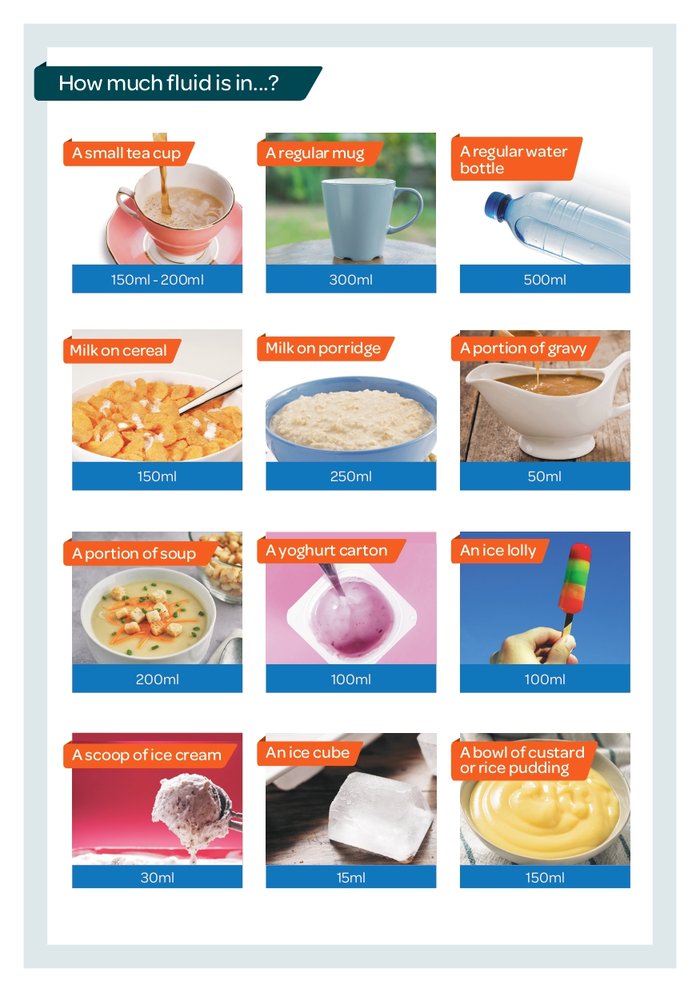This information page explains why you may need to drink less fluid and how you can manage this. Check with your kidney team before you follow this advice to make sure it applies to you. This is because reducing your fluid if you haven’t been advised to may cause harm.
What counts as fluid?
Any liquid that you drink, including those taken with medications, counts as fluid. Sometimes fluid foods such as soup, gravy, yoghurt, custard and jelly also need to be included in the amount of fluid you can have. Solid foods are not counted.
Why would I need to drink less?
Healthy kidneys control the amount of fluid in your body. This is known as fluid balance. Excess water normally leaves your body as urine. However, if you have problems with your kidneys, they might not make enough urine to get rid of extra fluid. This extra fluid will then build up in the body. This is known as fluid overload.
How can fluid overload cause problems?
Fluid overload can cause parts of your body to swell and look puffy. This is especially noticeable and uncomfortable around your ankles and eyes.
Fluid overload can also put a strain on your heart and lungs, causing problems such as:
- headaches
- high blood pressure
- breathlessness due to fluid on the lungs
- chest pain/angina due to fluid build-up around the heart
At the other extreme, not drinking enough fluid, or losing too much due to sickness or diarrhoea, can also cause problems as it can result in dehydration. It is therefore important to maintain the right fluid balance.

How much can I drink?
Your kidney team will work out the amount of fluid that you can drink each day to keep healthy. This is sometimes known as your fluid allowance.
Your fluid allowance will depend on your:
- stage of kidney disease
- treatment, such as dialysis
- blood pressure
- weight
- urine production
Everyone’s fluid allowance is different. You may be advised to drink more or less than someone else, even if they are on the same type of treatment. Your own fluid allowance may change over time as your treatment progresses or changes. You may be advised to temporarily reduce your fluid intake if you are showing any of the signs of fluid overload that are listed above.
You may be asked to measure the amount of urine that you pass in a day to help calculate your fluid balance.
How can I monitor my fluid intake?
You may need to measure the amount you drink each day. Your dietitian can help you with this.
Measure the amount of fluid that your favourite cup, mug or glass holds to calculate how many drinks you can have.
Take note of the amount of fluid contained in any bottles or cans that you drink.
Measure your fluid allowance into a jug in the morning. Every time you drink, take that amount away from the jug, so you know how much you have left.
Try to keep to your recommended fluid allowance as it has been calculated to keep you healthy.
Tips to help you drink less
You may find it hard to keep to your fluid allowance at first. Discuss any concerns you may have with your team.
The following tips may help:
- Use a small cup.
- Spread your drinks throughout the day.
- Take small sips rather than big gulps.
- Freeze a drink in a plastic bottle and sip it as it defrosts.
- Suck on ice cubes as they last longer than water.
- Chew sugar free gum or suck on sugar free mints.
- Rinse your mouth with mouthwash.
- Choose cold rather than hot drinks to better quench your thirst.
- Tell your friends and relatives that you are on a fluid allowance and ask them for their support.
Useful conversions
1 teaspoon = 5 ml
1 tablespoon = 15 ml
1 pint = approx. 570 ml
1 litre = 1000 ml / approx. 1.8 pints

How can I control my thirst?
Check your blood sugar control (if you have diabetes)
If you have diabetes, high blood glucose (sugars) can make you more thirsty. For support, speak to your dietitian or diabetes team.
Reduce your salt intake
Salt can make you feel thirsty which may make it hard to keep to your fluid allowance. Instead of adding salt in cooking, try adding fresh or dried herbs to dishes, or marinating meat and fish to give them more flavour. Use fresh or frozen meat, fish and vegetables, rather than pre-prepared dishes or ready meals.
Avoid any salt substitutes which list potassium chloride on the ingredients list, including SoLo®, Lo-Salt® or sodium-free salt.
You can also reduce the amount of salt you eat by having less:
- Very salty foods, such as bacon, ham, sausages, burgers or smoked fish
- Processed foods such as ready meals, cooking sauces in jars or packet sauces, take-aways and baked goods
- Salty snacks such as crisps and salted nuts
- Salt at the table
Where can I find out more information?
- Kidney Care UK: Adjusting to a fluid restriction diet
- FoodSwitch UK - a free smartphone app that helps you make healthier food choices

Publication date: 05/2024
Review date: 05/2027